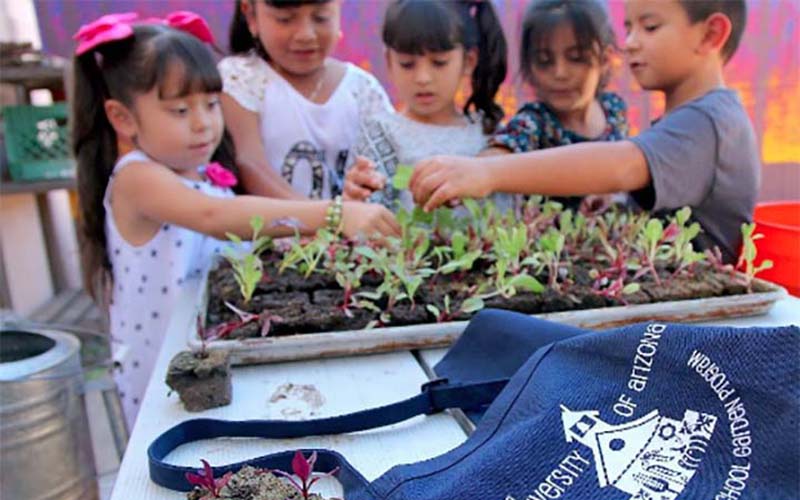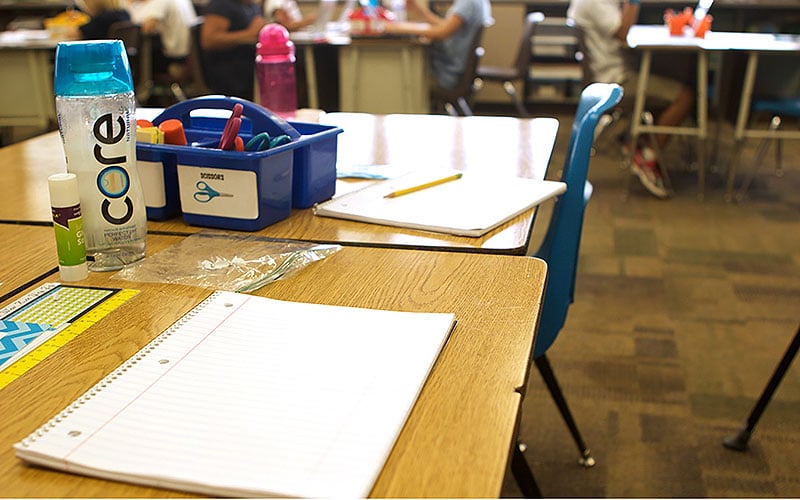
Supporters of the Community and School Garden Program in Tucson say that not only does it provide fresh, healthy food, but working in the garden improves kids’ mental health and teaches teamwork. (Photo courtesy Community and School Garden Program)
WASHINGTON – Moses Thompson wasn’t getting very far years ago when he went door-to-door to check with parents on absentee students, as part of his job with the Tucson Unified School District .
That was before the gardens.
“Once we opened the program, we weren’t ambushing parents, because those parents were at school transforming the schoolyard,” said Thompson, who now directs the Community and School Garden Program at 18 schools in the district.
He joined advocates from around the country Wednesday to testify at a House Rules Committee roundtable on the ways that schools can help fight childhood hunger, with programs ranging from gardens to culinary programs to simple outreach.
“One in six kids in America went to bed hungry and woke up hungry at some point during the year,” said Rep. Jim McGovern, D-Mass., the committee chairman. “Think about that: One in six kids in this country don’t know where their next meal is coming from. It’s just plain wrong.
“Let’s be clear. Schools are the backbone of efforts to end child hunger in this country and for many kids they are the only places where they can reliably get a healthy, nutritious meal all day,” McGovern said in his opening remarks.
But witnesses at the hearing said providing meals to students is just the first step. Schools have to ensure they are also providing healthy meals.
“It should be a birthright in this country, one of the richest on the planet, that every child has access to healthy food every day and that no child is ever hungry,” said Ann Cooper, founder of the Chef Ann Foundation, a nonprofit organization that promotes scratch cooking in schools.
The Arizona Department of Education last week announced the “Creating Your Kitchen” program, in collaboration with the Chef Ann Foundation, to “support schools in their work to exceed standards, and provide their students with healthy, nutritious meals.” The initiative aims to help schools serve more fresh foods instead of prepackaged and pre-made meals.
“Over the past year, it has become clear to everyone that one of our schools most essential services is providing healthy, nutritious meals to every student,” Superintendent of Public Instruction Kathy Hoffman said in a statement announcing the program.
The past year has posed new challenges for school nutrition. During the pandemic, many students lost “the most stable place in their lives” when their schools shut down, said Barbara Duffield, executive director of Schoolhouse Connection.
“Schools are not only the best, but often the only source of food and support some students receive,” Duffield said during the roundtable.
While schools were closed, the Tucson district shifted to grab-and-go lunches. But the work of the Community and School Garden Program, which Thompson runs in collaboration with the University of Arizona, did not stop.
The program, which is focused on Title I schools and low-income communities, said it harvested 350 pounds of produce in the 2020-2021 school year. Produce was included in the district’s grab-and-go lunches, and any food that was not used in the school cafeteria was donated to families and staff who needed it.
While food-insecure students can once again rely on warm meals at school now that in-person classes have resumed, Duffield said it is important for schools to identify the students who rely on school meals the most and provide them with extra assistance.
In Arizona, 311,390 children face food insecurity, according to the Arizona Food Bank Network. But Thompson said helping to provide children with food it just one of the benefits of the gardening program.
The program collaborates with schools to “foster cooperation, autonomy and social justice,” according to its website. It also helps “teachers introduce students to ‘real-world’ applications of what they learn in the classroom.”

When schools were closed by the pandemic, the Community and School Garden Program in Tucson sent produce home in lunches or distributed it to local families. (Photo courtesy Community and School Garden Program)
Thompson, a former counselor at Manzo Elementary School, used his interest in gardening to step out of his office and teach kids to work together.
School gardens “are places to practice mindfulness, emotional self-regulation and are places to connect meaningfully with other people,” Thompson said.
There are other benefits as well, said Cooper, who saw the impact school gardens had on students during 11 years as director of food services at the Boulder Valley School District in Colorado.
“School gardens are an integral part of getting kids to eat healthy food,” Cooper said. “If they grow the food, they eat the food.”
That was echoed by Thompson, who said, “The way we eat impacts how we feel, and the way we feel impacts how we eat.”
Despite the ongoing challenges, Thompson said he is optimistic.
“It’s important to remember that these are human-caused problems,” he said of childhood hunger. “But there are human-driven solutions to all of this stuff that feels impossible.”

